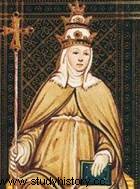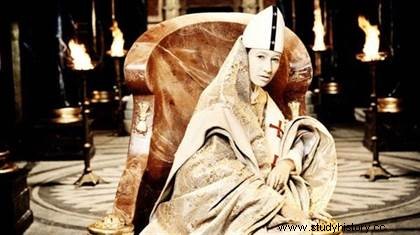 At the end of the Middle Ages, a curious rumor circulated in Europe:a woman (the Pope Joan ?) would have occupied the papal throne between the year 855 and the year 858 under the name of John VIII the Angelica. After returning to orders, she would have become a cardinal and was then elected pope. She would have died in childbirth during a procession. Until the 16th century, the Church did not deny this, before changing its mind and refuting the existence of this cumbersome and far from apostolic popess.
At the end of the Middle Ages, a curious rumor circulated in Europe:a woman (the Pope Joan ?) would have occupied the papal throne between the year 855 and the year 858 under the name of John VIII the Angelica. After returning to orders, she would have become a cardinal and was then elected pope. She would have died in childbirth during a procession. Until the 16th century, the Church did not deny this, before changing its mind and refuting the existence of this cumbersome and far from apostolic popess.
From Joan the Englishwoman to John VIII the Angelica
If we are to believe medieval sources, Joan, of English origin, was born near Mainz in Germany in 822. Eager to learn at a time when the rare circles of education and knowledge were reserved for clerics, she would have passed for a man, which would have opened the doors to several universities and abbeys, including that of Saint-Germain-des-Prés.
Arrived in Rome, she would have been noted for her knowledge, her piety as well as for her beauty and would have obtained a post of reader of the Holy Scriptures before joining the Roman curia where she would have ended up becoming a cardinal. On the death of Pope Leo IV in 855, she would have succeeded him under the name of John VIII the Angelica. She would then have acquitted herself of her task perfectly, until an unfortunate incident. In 858, during a procession, she would have had convulsions before giving birth to a child. Stoned by the angry crowd, dead in childbirth or simply immediately deposed, the pontificate of Pope Joan ends abruptly against a backdrop of scandal.
It is also following this event that another legend would have been born, that of the ceremony of the commode, on which the elected popes had to sit before their investiture to ensure their virility...
Medieval sources on Pope Joan
 During the High Middle Ages, the existence of Pope Joan is regularly mentioned in many books including, among others, the Chronicon pontificum et imperatorum (the Chronicle of the Popes and Emperors) by the Dominican Martin de Troppau, or in the Chronica universalis of Jean de Mailly, another Dominican. Pope Leo IX himself is said to have referred in a letter to the Patriarch of Constantinople, in the middle of the 11th century, to a “woman who occupied the seat of the pontiffs of Rome”.
During the High Middle Ages, the existence of Pope Joan is regularly mentioned in many books including, among others, the Chronicon pontificum et imperatorum (the Chronicle of the Popes and Emperors) by the Dominican Martin de Troppau, or in the Chronica universalis of Jean de Mailly, another Dominican. Pope Leo IX himself is said to have referred in a letter to the Patriarch of Constantinople, in the middle of the 11th century, to a “woman who occupied the seat of the pontiffs of Rome”.
Only one fact is certain:until the beginning of the 16th century, the historical existence of the Popess was admitted by all, since dignitaries of the Church went about it guarantors in writings that Rome does not see fit to censor. It cannot be argued, therefore, that the story of Joan was fabricated by detractors of the Church for anticlerical motives. On the contrary, the first author to take a stand against the existence of a female pope, in 1647, was a Protestant named David Blondel.
Benedict III, a substitute pope?
The incredible aspect of the story of this Pope Joan nevertheless echoes the confusion that reigns around the pope recognized today as the immediate successor of Leo IV:Benedict III . Its existence is not mentioned in the oldest known copy of the Liber Pontificalis , the chronological list of popes and bishops of Rome kept until the tenth century. The rare chroniclers who mention him speak of him by attributing to him a beautiful physique and an aversion to public appearances... We know practically nothing else about him, except that an antipope tried to impose himself against him and that he died suddenly in 858, refusing to be buried in St. Peter's Basilica, considering himself "unworthy to place himself near the saints .
 All of these facts can apply to the reign of the mysterious Popess, as well as to that of the uncertain Benedict. Would the official history of the Church have renamed Joan, or John VIII the Angelica, calling her Benedict to better conceal her gender? A final confusion may also have arisen between two pontiffs. A little later, during the ninth century, in fact, another pope bears the name of John VIII in 872. His existence, this time, is proven. However, some documents nicknamed him "the Popess", because of her weakness in the face of the Saracens and her supposed homosexuality. Do the two characters really have nothing to do with each other, or did a confusion arise after the fact between the little-known successor of Leo IV and a historic Pope John?
All of these facts can apply to the reign of the mysterious Popess, as well as to that of the uncertain Benedict. Would the official history of the Church have renamed Joan, or John VIII the Angelica, calling her Benedict to better conceal her gender? A final confusion may also have arisen between two pontiffs. A little later, during the ninth century, in fact, another pope bears the name of John VIII in 872. His existence, this time, is proven. However, some documents nicknamed him "the Popess", because of her weakness in the face of the Saracens and her supposed homosexuality. Do the two characters really have nothing to do with each other, or did a confusion arise after the fact between the little-known successor of Leo IV and a historic Pope John?
It is more likely that beneath the legend hides the vicissitudes of a Vatican history under the influence of Roman customs of the time, often troubled and chaotic, even sulfurous, until until the Counter-Reformation brought some semblance of order to it in the 16th century.
To go further
- Pope Joan, by Alain Bourreau. Champs Flammarion, 1993.
- Pope Joan, film by Sönke Wortmann, 2009.
